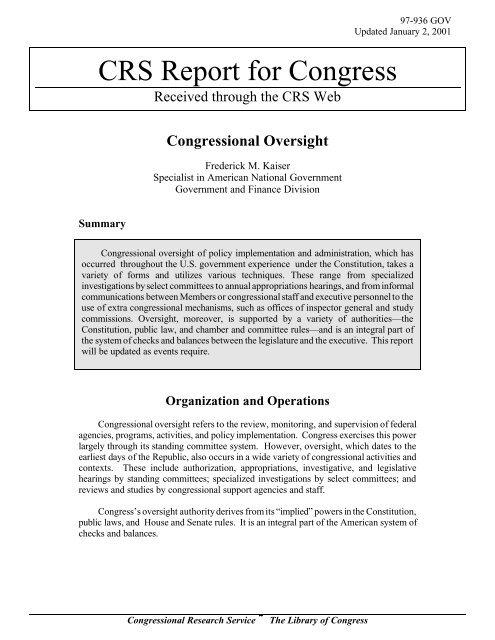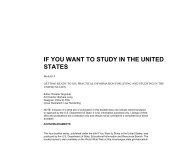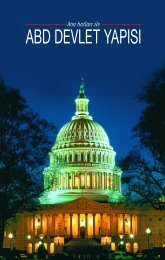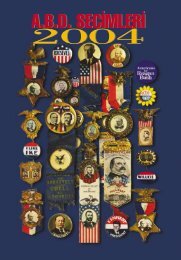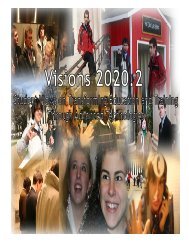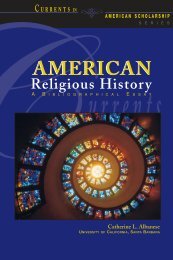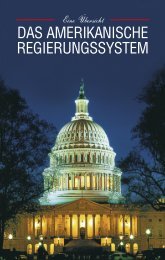CRS Report for Congress - About the USA
CRS Report for Congress - About the USA
CRS Report for Congress - About the USA
- No tags were found...
Create successful ePaper yourself
Turn your PDF publications into a flip-book with our unique Google optimized e-Paper software.
<strong>CRS</strong> <strong>Report</strong> <strong>for</strong> <strong>Congress</strong>Received through <strong>the</strong> <strong>CRS</strong> Web97-936 GOVUpdated January 2, 2001<strong>Congress</strong>ional OversightFrederick M. KaiserSpecialist in American National GovernmentGovernment and Finance DivisionSummary<strong>Congress</strong>ional oversight of policy implementation and administration, which hasoccurred throughout <strong>the</strong> U.S. government experience under <strong>the</strong> Constitution, takes avariety of <strong>for</strong>ms and utilizes various techniques. These range from specializedinvestigations by select committees to annual appropriations hearings, and from in<strong>for</strong>malcommunications between Members or congressional staff and executive personnel to <strong>the</strong>use of extra congressional mechanisms, such as offices of inspector general and studycommissions. Oversight, moreover, is supported by a variety of authorities—<strong>the</strong>Constitution, public law, and chamber and committee rules—and is an integral part of<strong>the</strong> system of checks and balances between <strong>the</strong> legislature and <strong>the</strong> executive. This reportwill be updated as events require.Organization and Operations<strong>Congress</strong>ional oversight refers to <strong>the</strong> review, monitoring, and supervision of federalagencies, programs, activities, and policy implementation. <strong>Congress</strong> exercises this powerlargely through its standing committee system. However, oversight, which dates to <strong>the</strong>earliest days of <strong>the</strong> Republic, also occurs in a wide variety of congressional activities andcontexts. These include authorization, appropriations, investigative, and legislativehearings by standing committees; specialized investigations by select committees; andreviews and studies by congressional support agencies and staff.<strong>Congress</strong>’s oversight authority derives from its “implied” powers in <strong>the</strong> Constitution,public laws, and House and Senate rules. It is an integral part of <strong>the</strong> American system ofchecks and balances.<strong>Congress</strong>ional Research Service The Library of <strong>Congress</strong>
<strong>CRS</strong>-2Principles and PurposesUnderlying <strong>the</strong> legislature's ability to oversee <strong>the</strong> executive are democratic principlesas well as practical purposes. John Stuart Mill, <strong>the</strong> British Utilitarian philosopher, insistedthat oversight was <strong>the</strong> key feature of a meaningful representative body: “The proper officeof a representative assembly is to watch and control <strong>the</strong> government.” 1 As a young scholarand future President, Woodrow Wilson—in his 1885 treatise, <strong>Congress</strong>ionalGovernment—equated oversight with lawmaking, which was usually seen as <strong>the</strong> supremefunction of a legislature. He wrote, “Quite as important as legislation is vigilant oversightof administration.” 2The philosophical underpinning <strong>for</strong> oversight is <strong>the</strong> Constitution’s system of checksand balances among <strong>the</strong> legislature, executive, and judiciary. James Madison, known as<strong>the</strong> “Fa<strong>the</strong>r of <strong>the</strong> Constitution,” described <strong>the</strong> system in Federalist No. 51 as establishing“subordinate distributions of power, where <strong>the</strong> constant aim is to divide and arrange <strong>the</strong>several offices in such a manner that each may be a check on <strong>the</strong> o<strong>the</strong>r.”Oversight, as an outgrowth of this principle, ideally serves a number of overlappingobjectives and purposes:! improve <strong>the</strong> efficiency, economy, and effectiveness of governmental operations;! evaluate programs and per<strong>for</strong>mance;! detect and prevent poor administration, waste, abuse, arbitrary and capriciousbehavior, or illegal and unconstitutional conduct;! protect civil liberties and constitutional rights;! in<strong>for</strong>m <strong>the</strong> general public and ensure that executive policies reflect <strong>the</strong> publicinterest;! ga<strong>the</strong>r in<strong>for</strong>mation to develop new legislative proposals or to amend existingstatutes;! ensure administrative compliance with legislative intent; and! prevent executive encroachment on legislative authority and prerogatives.In sum, oversight is a way <strong>for</strong> <strong>Congress</strong> to check on, and check, <strong>the</strong> executive.1John Stuart Mill, Considerations on Representative Government (London: Parker, Son, andBourn, 1861), p. 104.2 Woodrow Wilson, <strong>Congress</strong>ional Government (Boston: Houghton Mifflin, 1885), p. 297.
The U.S. Constitution<strong>CRS</strong>-3Powers and PrerogativesAlthough <strong>the</strong> Constitution grants no <strong>for</strong>mal, express authority to oversee orinvestigate <strong>the</strong> executive or program administration, oversight is implied in <strong>Congress</strong>’simpressive array of enumerated powers. 3 The legislature is authorized to appropriatefunds; raise and support armies; provide <strong>for</strong> and maintain a navy; declare war; provide <strong>for</strong>organizing and calling <strong>for</strong>th <strong>the</strong> national guard; regulate interstate and <strong>for</strong>eign commerce;establish post offices and post roads; advise and consent on treaties and presidentialnominations (Senate); and impeach (House) and try (Senate) <strong>the</strong> President, Vice President,and civil officers <strong>for</strong> treason, bribery, or o<strong>the</strong>r high crimes and misdemeanors.Rein<strong>for</strong>cing <strong>the</strong>se powers is <strong>Congress</strong>’s broad authority “to make all laws which shallbe necessary and proper <strong>for</strong> carrying into execution <strong>the</strong> <strong>for</strong>egoing powers, and all o<strong>the</strong>rpowers vested by this Constitution in <strong>the</strong> Government of <strong>the</strong> United States, or in anyDepartment or Officer <strong>the</strong>reof.”The authority to oversee derives from <strong>the</strong>se constitutional powers. <strong>Congress</strong> couldnot carry <strong>the</strong>m out reasonably or responsibly without knowing what <strong>the</strong> executive is doing;how programs are being administered, by whom, and at what cost; and whe<strong>the</strong>r officialsare obeying <strong>the</strong> law and complying with legislative intent. The Supreme Court haslegitimated <strong>Congress</strong>’s investigative power, subject to constitutional safeguards <strong>for</strong> civilliberties. In 1927, <strong>the</strong> Court found that, in investigating <strong>the</strong> administration of <strong>the</strong>Department of Justice, <strong>Congress</strong> was considering a subject “on which legislation could behad or would be materially aided by <strong>the</strong> in<strong>for</strong>mation which <strong>the</strong> investigation was calculatedto elicit.” 4StatutesThe “necessary and proper” clause of <strong>the</strong> Constitution also allows <strong>Congress</strong> to enactlaws that mandate oversight by its committees, grant relevant authority to itself and itssupport agencies, and impose specific obligations on <strong>the</strong> executive to report to or consultwith <strong>Congress</strong>, and even seek its approval <strong>for</strong> specific actions.Broad oversight mandates exist <strong>for</strong> <strong>the</strong> legislature in several significant statutes. TheLegislative Reorganization Act of 1946 (P.L. 79-601), <strong>for</strong> <strong>the</strong> first time, explicitly called<strong>for</strong> “legislative oversight” in public law. It directed House and Senate standing committees“to exercise continuous watchfulness” over programs and agencies under <strong>the</strong>ir jurisdiction;authorized professional staff <strong>for</strong> <strong>the</strong>m; and enhanced <strong>the</strong> powers of <strong>the</strong> ComptrollerGeneral, <strong>the</strong> head of <strong>Congress</strong>’s investigative and audit arm, <strong>the</strong> General AccountingOffice (GAO). The Legislative Reorganization Act of 1970 (P.L. 91-510) authorized eachstanding committee to “review and study, on a continuing basis, <strong>the</strong> application,administration and execution” of laws under its jurisdiction; increased <strong>the</strong> professional staff3Article I, Sec. 8 and Article II, Secs. 2 and 4.4 McGrain v. Daugherty, 273 U.S. 135, 177 (1927); see also Watkins v. United States, 354U.S. 178, 187 (1957), and Barenblatt v. United States, 360 U.S. 109, 111 (1959).
<strong>CRS</strong>-4of committees; expanded <strong>the</strong> assistance provided by <strong>the</strong> <strong>Congress</strong>ional Research Service;and streng<strong>the</strong>ned <strong>the</strong> program evaluation responsibilities of GAO. The <strong>Congress</strong>ionalBudget Act of 1974 (P.L. 93-344) allowed committees to conduct program evaluation<strong>the</strong>mselves or contract out <strong>for</strong> it; streng<strong>the</strong>ned GAO’s role in acquiring fiscal, budgetary,and program-related in<strong>for</strong>mation; and upgraded GAO’s review capabilities.Besides <strong>the</strong>se general powers, numerous statutes direct <strong>the</strong> executive to furnishin<strong>for</strong>mation to or consult with <strong>Congress</strong>. For example, <strong>the</strong> Government Per<strong>for</strong>mance andResults Act of 1993 (P.L. 103-62) requires agencies to consult with <strong>Congress</strong> on <strong>the</strong>irstrategic plans and report annually on per<strong>for</strong>mance plans, goals, and results. In fact, morethan 2,000 reports are submitted each year to <strong>Congress</strong> by federal departments, agencies,commissions, bureaus, and offices. Inspectors general (IGs), <strong>for</strong> instance, report <strong>the</strong>irfindings about waste, fraud, and abuse, and <strong>the</strong>ir recommendations <strong>for</strong> corrective action,periodically to <strong>the</strong> agency head and <strong>Congress</strong>. The IGs are also instructed to issue specialreports concerning particularly serious problems immediately to <strong>the</strong> agency head, whotransmits <strong>the</strong>m unaltered to <strong>Congress</strong> within seven days. The <strong>Report</strong>s Consolidation Actof 2000 (P.L. 106-531), moreover, instructs <strong>the</strong> IGs to identify and describe <strong>the</strong>iragencies’ most serious management and per<strong>for</strong>mance challenges and briefly assessprogress in addressing <strong>the</strong>m. This new requirement is to be part of a larger ef<strong>for</strong>t byindividual agencies to consolidate <strong>the</strong>ir numerous reports on financial and per<strong>for</strong>mancemanagement matters into a single annual report. The aim is to enhance coordination andefficiency within <strong>the</strong> agencies; improve <strong>the</strong> quality of relevant in<strong>for</strong>mation; and provide itin a more meaningful and useful <strong>for</strong>mat <strong>for</strong> <strong>Congress</strong>, <strong>the</strong> President, and <strong>the</strong> public.In addition, <strong>Congress</strong> creates commissions and establishes task <strong>for</strong>ces to study andmake recommendations <strong>for</strong> select policy areas that can also involve examination ofexecutive operations and organizations.There is a long history behind executive reports to <strong>Congress</strong>. Indeed, one of <strong>the</strong> firstlaws of <strong>the</strong> First <strong>Congress</strong>—<strong>the</strong> 1789 Act to establish <strong>the</strong> Treasury Department (1 Stat.66)—called upon <strong>the</strong> Secretary and <strong>the</strong> Treasurer to report directly to <strong>Congress</strong> on publicexpenditures and all accounts. The Secretary was also required “to make report, and givein<strong>for</strong>mation to ei<strong>the</strong>r branch of <strong>the</strong> legislature ... respecting all matters referred to him by<strong>the</strong> Senate or House of Representatives, or which shall appertain to his office.”Separate from such reporting obligations, public employees may provide in<strong>for</strong>mationto <strong>Congress</strong> on <strong>the</strong>ir own. In <strong>the</strong> early part of <strong>the</strong> 20 th century, <strong>Congress</strong> enactedlegislation to overturn a “gag” rule, issued by <strong>the</strong> President, that prohibited employeesfrom communicating directly with <strong>Congress</strong> (5 U.S.C. 7211 (1994)). O<strong>the</strong>r“whistleblower” statutes, which have been extended specifically to cover personnel in <strong>the</strong>intelligence community (P.L. 105-272), guarantee <strong>the</strong> right of government employees topetition or furnish in<strong>for</strong>mation to <strong>Congress</strong> or a Member.House and Senate RulesChamber rules also rein<strong>for</strong>ce <strong>the</strong> oversight function. House and Senate rules, <strong>for</strong>instance, provide <strong>for</strong> “special oversight” or “comprehensive policy oversight,”respectively, <strong>for</strong> specified committees over matters that relate to <strong>the</strong>ir authorizingjurisdiction. In addition, House rules direct each standing committee to require itssubcommittees to conduct oversight or to establish an oversight subcommittee <strong>for</strong> this
<strong>CRS</strong>-5purpose. House rules also call <strong>for</strong> each committee to submit an oversight agenda, listingits prospective oversight topics <strong>for</strong> <strong>the</strong> ensuing <strong>Congress</strong>, to <strong>the</strong> House Committee onGovernment Re<strong>for</strong>m, which compiles and prints <strong>the</strong> agendas.The House Government Re<strong>for</strong>m Committee and <strong>the</strong> Senate Governmental AffairsCommittee, which have oversight jurisdiction over virtually <strong>the</strong> entire federal government,fur<strong>the</strong>rmore, are authorized to review and study <strong>the</strong> operation of government activities todetermine <strong>the</strong>ir economy and efficiency and to submit recommendations based on GAOreports. In addition, House rules require that <strong>the</strong> findings and recommendations from <strong>the</strong>Government Re<strong>for</strong>m Committee be considered by authorizing panels, if presented to <strong>the</strong>min a timely fashion.Activities and AvenuesOversight occurs through a wide variety of congressional activities and avenues.Some of <strong>the</strong> most publicized are <strong>the</strong> comparatively rare investigations by selectcommittees into major scandals or into executive branch operations gone awry. Cases inpoint are temporary select committee inquiries into: China’s acquisition of U.S. nuclearweapons in<strong>for</strong>mation, in 1999; <strong>the</strong> Iran-Contra affair, in 1987; intelligence agency abuses,in 1975-1976, and “Watergate,” in 1973-1974. The precedent <strong>for</strong> this kind of oversightactually goes back two centuries: in 1792, a special House committee investigated <strong>the</strong>ignominious defeat of an Army <strong>for</strong>ce by confederated Indian tribes. By comparison to<strong>the</strong>se select panel investigations, o<strong>the</strong>r congressional inquiries in recent <strong>Congress</strong>es—intoWhitewater, access to Federal Bureau of Investigation files, White House Travel Officefirings, and campaign financing—have relied upon standing committees.The impeachment proceedings against President Clinton in 1998 in <strong>the</strong> House andin 1999 in <strong>the</strong> Senate also generated considerable oversight. It not only encompassed <strong>the</strong>President and <strong>the</strong> White House staff, but also extended to <strong>the</strong> office of independentcounsel, prompted by concerns about its authority, jurisdiction, and expenditures.Although such highly visible endeavors are significant, <strong>the</strong>y usually reflect only asmall portion of <strong>Congress</strong>’s total oversight ef<strong>for</strong>t. More routine and regular review,monitoring, and supervision occur in o<strong>the</strong>r congressional activities and contexts.Especially important are appropriations hearings on agency budgets as well asauthorization hearings <strong>for</strong> existing programs. Separately, examinations of executiveoperations and <strong>the</strong> implementation of programs—by congressional staff, support agencies,and specially created commissions and task <strong>for</strong>ces—provide additional oversight.Selected ReferencesJoel D. Aberbach, Keeping Watchful Eye: The Politics of <strong>Congress</strong>ional Oversight(Washington: Brookings Institution, 1990).Frederick M. Kaiser, “<strong>Congress</strong>ional Oversight of <strong>the</strong> Presidency,” Annals, vol. 499, Sept.1988, pp. 75-89.David R. Mayhew, Divided We Govern: Party Control, Lawmaking, and Investigations,1946-1990 (New Haven: Yale University Press, 1991).
<strong>CRS</strong>-6Walter J. Oleszek, “Legislative Oversight,” <strong>Congress</strong>ional Procedure and <strong>the</strong> PolicyProcess (Washington: <strong>Congress</strong>ional Quarterly Press, 2001), pp. 274-297.Arthur M. Schlesinger and Roger Bruns, eds., <strong>Congress</strong> Investigates: A DocumentedHistory, 1792-1974, 5 vols. (New York: Chelsea House Publishers, 1975).Charles Tiefer, “<strong>Congress</strong>ional Oversight of <strong>the</strong> Clinton Administration and <strong>Congress</strong>ionalProcedure,” Administrative Law Review, vol. 50, Winter 1998, pp. 199-216.U.S. <strong>Congress</strong>, House Committee on House Administration, “Oversight,” History of <strong>the</strong>House of Representatives, 1789-1994, H.Doc. 103-324, 103 rd Cong., 2 nd sess.(Washington: GPO, 1994), pp. 233-266.U.S. General Accounting Office, Investigators’ Guide to Sources of In<strong>for</strong>mation, GAO<strong>Report</strong> OSI-97-2 (Washington: 1997).<strong>CRS</strong> Products<strong>CRS</strong> <strong>Report</strong> RL30240 (1999), <strong>Congress</strong>ional Oversight Manual (1999).<strong>CRS</strong> <strong>Report</strong> 97-382 (1997), Government Per<strong>for</strong>mance and Results Act: Implications <strong>for</strong><strong>Congress</strong>ional Oversight, by Frederick M. Kaiser and Virginia A. McMurtry.<strong>CRS</strong> <strong>Report</strong> 95-464 (1995), Investigative Oversight, by Morton Rosenberg.<strong>CRS</strong> Video programs (1999), VB 60016, Constitutional Context of Oversight;VB60019,Fiscal Oversight; VB60015, Oversight: A Key <strong>Congress</strong>ional Function; VB60017,The Rules and Tools of Oversight; VB60018, Sources of Oversight Assistance.


